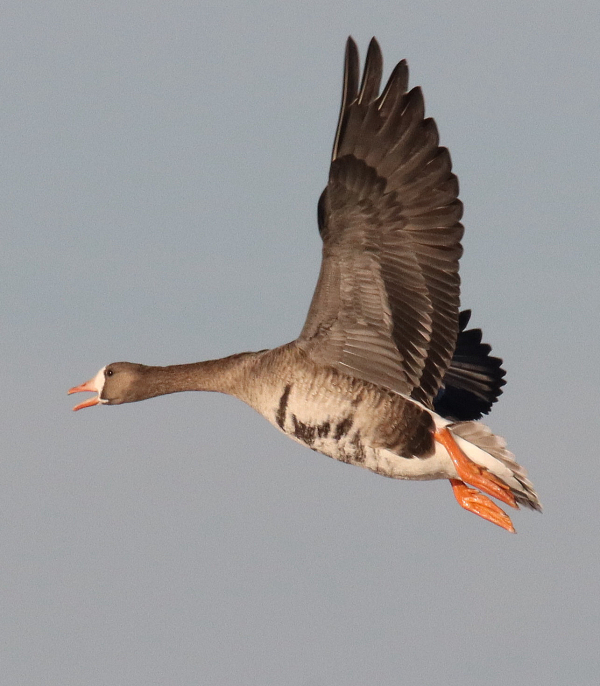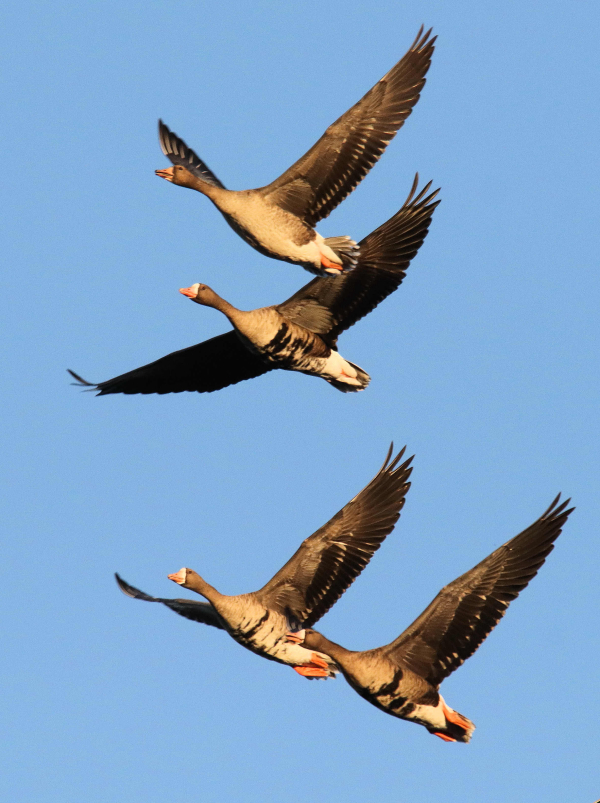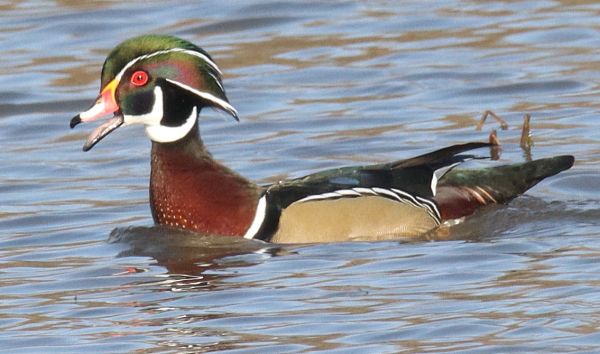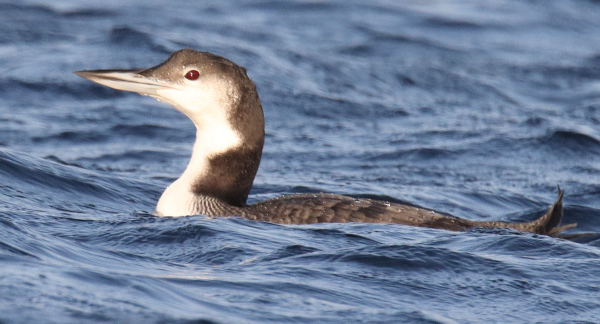
The first Arctic-nesting geese arrived Sunday, with White-fronted Geese making up 99 percent of the newly arrived flocks.

Many young White-fronted Geese were among the first flocks that arrived Sunday. The top goose in the above photo is a first-fall migrant in the company of 3 adults.

A surprise opportunity to photograph Wood Ducks during a day trip to Minnesota was a highlight during a fruitful afternoon of birding last Wednesday.

The chance of photographing a Common Loon in winter plumage seemed remote this late in the season, but not only did an adult eventually appear, but a separate young loon was also encountered. You can see more photos in the Bird Photography feature in this issue.
|
The first big flocks of Arctic-nesting geese suddenly appeared Sunday – hundreds of White-fronted Geese with a few Snow Geese mixed in! Their vibrant calls filled the landscape, which is always a turning point of fall and reason for personal celebration. After a mid-afternoon observation of the huddled masses, I made the most of their appearance at Napolean Lake by returning as the sun was low in the western sky to photograph some of the flocks as they left the lake to feed in a harvested cornfield to the south – flock after flock, 20 to 50 at a time.
I initially thought there were about 600 White-fronts and maybe 45 Snow Geese, but I’m sure that was quite an underestimate. There were also 2 Tundra Swans, a few Canada Geese, and at least 1 pair of Ross’s Geese. I checked the flocks for Cackling Geese too, but found none; but there were a couple family groups of Snow Geese, and about 5 blue-morph Snow Geese too. There were plenty of ducks – mostly Mallards, some Lesser Scaup, Northern Shovelers, Northern Pintails, and a few newly arrived American Wigeons and Buffleheads – all adding up to a brilliant waterfowl extravaganza. Add some late White Pelicans, cormorants, Ring-billed Gulls, and many coots, and you have the full list of birds, all numbering far more than 1,000 birds in sight.
Between my Napolean Lake visits I extended my birding drive another hour to check on Long Lake National Wildlife Refuge, where I found quite a change overall. First, I sighted no Sandhill Cranes immediately north of the refuge, where I have photographed cranes a couple times during recent week. Just as pronounced was the near-absence of Double-crested Cormorants and Western Grebes, Mourning Doves and Western Meadowlarks; with far fewer White Pelicans. I eventually found a small flock of Sandhill Cranes resting on the south side of Long Lake, and another similar-sized flock in the marsh on the south side of the lake. That’s where there was a large flock of White-fronted Geese, numbering about 300, with some Northern Shovelers, Green-winged Teal, and a small flock of Long-billed Dowitchers in the marsh.
Another seasonal first was a Northern Shrike, down from somewhere in the species’ northern boreal forest nesting range. A quite colorful male Merlin was also a standout between Napolean Lake and Long Lake, and during the full drive I only counted widely scattered raptors, 11 Red-tailed Hawks and 4 Northern Harriers. Both species have showed steady declines through October’s migration period, which is the norm. As I began my Sunday drive, the appearance of 6 and 16 Tundra Swans not far from home in wetlands where I’ve never seen them before gave me the impression that many more swans might be spread across the Coteau region. That wasn’t the case, and as it turned out only a single Tundra Swan was sighted beyond Cindy’s Lake, where I estimated about 60 swans, down a hundred or so from 8 days earlier – but more swans will follow, along with tens of thousands more geese.
Minnesota Return
Anxious to get back on the water in Minnesota during October migration and primo fall colors, the promise of an exciting afternoon of birding with some photo ops propelled me east as I Iooked forward to catching up with my friend Andy at the Pelican Lakes. A Bald Eagle and Common Raven seemed like good omens before I turned off at the little town of Audubon toward my friend Linda’s lake home. Linda was back in Hollywood, but I wanted to check for the Trumpeter Swan families between her summer home and Andy’s place – I observed and photographed 3 swan families along that route in early September.
The 2 marshes close to the road that held swans 6 weeks before were empty, but the third marsh with the beaver lodge still held a distant pair with 3 gray cygnets. Oh well, the swans were a second thought anyway; I was really hoping for what seemed like a near-impossible very late season Common Loon in full winter plumage on Andy’s lake. But wait! There was a small marsh on the edge of a colorful woodland with lots of white bodies with long white necks – Trumpeter Swans. As I slowed down and trees began to obscure the marsh, a gravel road appeared that permit me to get closer to the marsh and the swans.
Better yet, the road directed me to the perfect location at the far end of the marsh where 18 Trumpeters were in sight, most fairly close for photography. That’s when I realized there were also some Wood Ducks, which were even more attractive to my camera! Mixed in with 14 Mallards and 6 Canada Geese, the 7 Wood Ducks appeared to be feeding on grains of wild rice in the water. They were a bit out of the range of my zoom lens, but the big swans were close and showed little concern for my arrival. With the stage set, I’m going to refer you to my Bird Photography feature in this issue for the rest of the story and a variety of photographs taken that eventful afternoon with my buddy Andy.
Near My Office
Sunday was also an Arctic goose day in my home range, with more than 150 White-fronted Geese and the first 3 Snow Geese present 3 miles north of my office. A smaller flock of about 45 White-fronts mixed with 13 Tundra Swans and a Giant Canada Goose were also present at Swan Marsh about 10 miles to the south. Tundra Swans have been scattered and on the move since they arrived, with 14, 1, and 6 at local marshes Thursday, and Saturday there were 11 Tundra Swans and 34 American Avocets at Dean’s Lake just a mile northeast of home, but I haven’t seen any swans there since. Other Saturday finds included a Great Blue Heron, 2 Great Egrets, 2 Greater Yellowlegs, about 20 Western Grebes, and a mixed flock of Redheads and Lesser Scaup that numbered about 200.
Last Wednesday, the harbinger of the northern birds that would begin to arrive last week was a dark morph Harlan’s Red-tailed Hawk, always an eventful sighting of an uncommon raptor in passage, probably from northwest Canada or Alaska. Here in the center of the continent, I am lucky to see a variety of plumage variations among Red-tails, most notably the Harlan’s and Krider’s Red-tails. The following day another hawk threw me off a bit as I sighted and confirmed a young Ferruginous Hawk, a species I haven’t seen for a couple months, with almost all expected to be in Great Plains states to the south by now.
A Monday highlight was watching a female Merlin pursue a small songbird in an acrobatic flight of tight twists and turns, with the Merlin fanning and turning its tail to stay in touch with the passerine that ultimately escaped. Merlins are considered to be the most acrobatic of all falcons, partly due to their small size and interest in hunting small birds on the wing. Nearby I also found a late immature Black-crowned Night Heron, and a Sharp-tailed Grouse that provided a portrait opportunity with my camera.
Even closer to my office, the calls of Blue Jays delighted me Thursday, Friday, and Saturday; and Monday I finally spied 2 jays in trees in my front yard within sight of my feeding station. At least 2 White-breasted Nuthatches were especially active collecting and caching seeds from Saturday until mid-afternoon Monday, but haven’t returned since. A number of House Finches also found my seed feeder stocked with shelled black oil sunflower seeds. A few Dark-eyed Juncos passed by Saturday, as did a White-throated Sparrow, but they have not zeroed in on dropped seeds at my feeding station yet.
Tuesday as I was putting the finishing touches on this issue, a few juncos foraged in my yard, now laced with fallen yellow leaves. But at mid-afternoon, the biggest thrill in my yard since the hummingbirds left appeared – the biggest bird too. A male Hairy Woodpecker alighted on my large tube feeder, checked it out, grabbed a seed, returned for another seed, and added appreciably to the excitement outside my bay windows that day and week.
All in all, it was a pivotal week in October, with new birds arriving, a few late birds on hand, others moving on, and fewer leaves on the trees each day. The arrival of the first Arctic-nesting geese is always a turning point and soon the flood gates will open for thousands of geese made up of 5 species to fill the crisp air with goose music and create clouds of waterfowl during their protracted fall stopover in this region. The avian action changes almost daily during this period, so it’s exciting to spend at least a little time each day to see what’s new – what species have arrived, and which birds moved on. For many of us, birding clears our mind, similar to what physical activity can do, and when we combine the two it elevates our mental and physical wellness. I know I sure enjoy a daily dose of birding! Get yours today!
Article and Photos by Paul Konrad
Share your bird sightings and photographs at editorstbw2@gmail.com